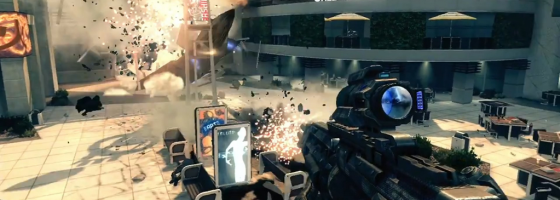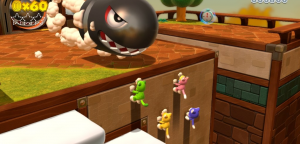Recently on Twitter, I finally drew a line in the sand that I’ve been thinking about for months: I can’t stand the state of modern game journalism and “game journalists.” Video Game Journalism, like game design before it, never really had a formal discussion of what it is, and in response, it’s given us a form of Video Game Journalism that I can’t get behind.
Games vs. Journalist:
Covering video games for a living is the dream job for a lot of people. With the rise of the internet and blogging came the ability for anyone who could talk about video games to make their opinions and thoughts known.
Today, every genre and platform has multiple game sites dedicated to covering it; with the term “Game Journalist” now an attractive title. Even people who have been recognized as Game Journalists from the ’90s never went to school to specifically talk about games.
As with making video games, the fact that anyone can do it has made Game Journalism attractive. Just as the Internet set up websites for Game Journalism, YouTube took things into video. Now, if you can’t get on a major site because of your writing, you can make videos sharing your thoughts on games. Those that prove successful may get hired as on air personalities, or just turn their channel into a news feed on games.
The problem and where my issues lie with how Game Journalism became focused only on one kind of reporting.
The Two Views of Game Journalism:
If you’re a long time fan of mine, you know how I feel about modern game sites and the content they put out. When it comes to covering video games, with exception to the rare expose pieces (EA Spouse, Silicon Knights, etc,) there are two kinds of ways to cover video games.
The first kind is that the author’s views are the focus on the story. You can see this with stories aimed at talking more about the author rather than the game or design itself. List features, anecdotal stories, or those meant to discuss why something is controversial, are just some of the examples.
Some sites have staked their reputation on these kinds of stories, and you will typically find them on most game sites, and the reasons why are very simple. They’re softball features that typically don’t get into detail about the games.
By focusing on the author, it’s a lot easier to write something directly from your own point of view rather than from an outside source. And perhaps the biggest reason, they can be emotionally charged, and drive traffic to a piece that goes viral. Even game reviews can be more about the author; focusing on how the game affected them as opposed to hard details about it.
The other kind is those that focus on the game or design itself. Some examples would be post mortems on games, a breakdown of a genre or design, or historical pieces meant to educate modern gamers on older games.
These pieces are rarely featured on major game sites, and there’s a very good reason why: They’re not as flashy. Most Game Magazines originated as fans getting together to talk about the games and news pieces that interested them. It’s a lot easier and showy to talk about how a game moved you than discussing how it worked. More importantly, most people who cover video games have spent very little time learning about the actual process of making a game, or talking to people beyond PR pieces.
The more I think about it, the less I can respect the title “Game Journalist,” and how it is the antithesis of what I want to learn about the Game Industry.
The Critical Eye:
When I think about the state of modern Game Journalism, it is more about glamorizing being a game journalist than actually talking about making games for a living. It’s rare on a major site to see a piece explore the inner workings of game design or behind the scenes with the developer.
My style has always been to look at game design the same way as a mechanic appreciates the technical beauty of building a car, or a craftsman examining hand-made design.
To me, it’s about the nuts and bolts under the surface that gets me interested in the design and creation of a video game. While there is nothing wrong with the other way of looking at games, it has pushed out analytical discussions from major sites and the mainstream.
I’ll probably get in trouble for saying this, but I’ll give you an example of the stories I do/don’t want to read. I don’t want to read a story on a major game site for the umpteenth time of how the game Gone Home moved you or reminded you of your childhood. I want to read a breakdown of how Fullbright used effective pacing and cues to passively guide the player around and had them experience the story.
I know what some of you are about to type below, “What’s the big deal with journalists writing stories about their personal investment in a game?” The problem with these pieces is that they don’t accurately represent what it means to make or examine games, and is a major cause for the lack of transparency in design.
The Break between Developers and Journalists:
One of the biggest things that have helped convince me to keep going with my talks and work has been talking to game designers around the world. A frequent compliment I get from designers is how great it is to spend time talking to someone who understands the craft of game design. From my fans, I hear that they love seeing these conversations unfold, as they’re not going to get them from anyone else.
Speaking to Game Journalists, it’s hard to actually carry a conversation about design, as you don’t know what their level of understanding is. When we see designers on interviews at other sources, the interview is always a softball discussion.
A lot of my personal interview style has come from watching people like Jon Stewart or Stephen Colbert and to make the guest actually have a discussion about the topic at hand. While I will have jokey questions, they’re not meant to guide the interview, but give the guest a moment to relax.
I would love to have my own sit-down interview show talking game design at some point, and try to bring that level of discussion to the mainstream audience. Speaking of the mainstream, it’s time to talk about what really bothers me about this issue.
Educating the Consumer:
It’s time to get serious for a moment. When it comes to information about the actual work in the game industry, we are terrible when it comes to educating our fans. Part of it is because game designers are too busy making games to have these talks, and the other reason is that Game Journalism doesn’t make an attempt to talk about them.
The reason why this is dangerous is that it gives a false view of what it means to make games for a living. One of my most popular presentations I’ve given so far was a “What to Expect When Entering the Game Industry,” talk.
I had a full room of parents and kids wanting to know more, because they weren’t finding this out anywhere else.
While there is a lot of information out there about how to play video games, there is very little in the mainstream about what it means to make them for a living. If you want the consumer to appreciate and understand the work that goes into game design, then they need to understand that there’s more to it than giving an interview on sites like IGN or Polygon, and “tightening up the graphics on level three.”
The Future of Video Game Journalism:
Video games, and by extension game design, are more prominent today than they were when I was growing up. The Game Industry is no longer looked at as a niche market that makes simple toys, but a multi-billion dollar industry capable of producing amazing works of art.
Just as what it means to make games have evolved, I’m hoping that we see a similar evolution on the side of covering them. And lastly, for any game designers reading this, as I said on Twitter, if you want to have a detailed discussion on the craft of game design with me, please get in touch.



